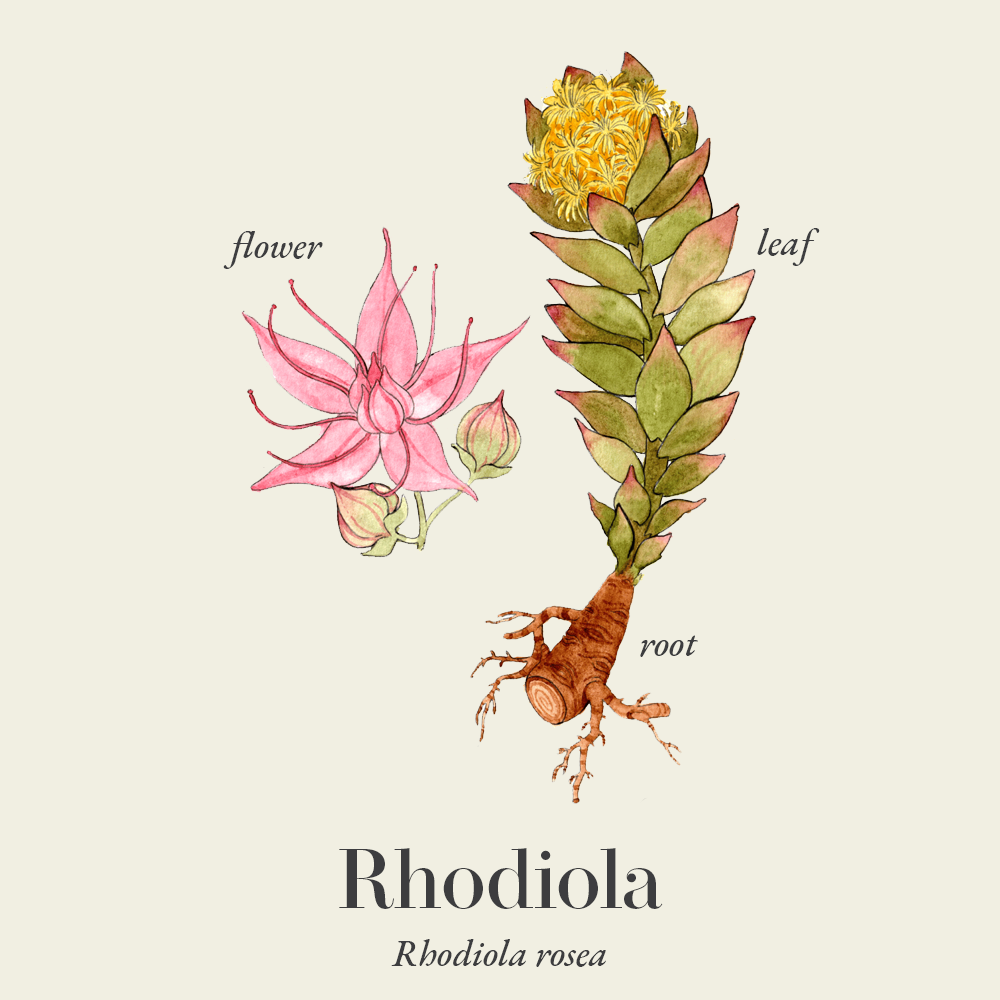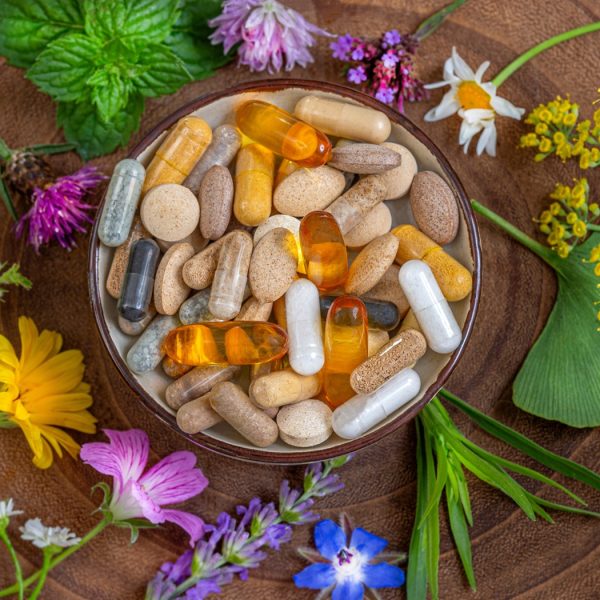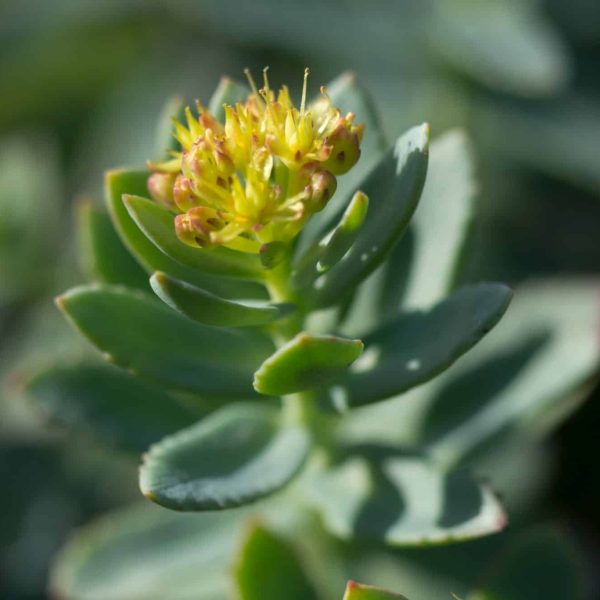-
How does it feel?
One of Rhodiola’s common names is Rose root. This is because the freshly cut roots have a very pleasant rose-like scent, which remains on drying to a degree. The dried and powdered root is slightly sweet with an aftertaste of bitterness and a definite astringency.
-
What can I use it for?
 When it comes to Rhodiola rosea, it is very important to ensure you are using the correct species, as products can be substituted with different species and there are more than one species of rhodiola.
When it comes to Rhodiola rosea, it is very important to ensure you are using the correct species, as products can be substituted with different species and there are more than one species of rhodiola.R. rosea can potentially benefit many presentations due to its direct effects on the mechanisms in the body that control the stress response.
It is classed as an adaptogen, assisting in enabling one to adapt and cope more effectively to stresses.
It increases physical and mental efficiency, it can enhance a moderately low mood, help to improve sleep quality, energy levels and enhance convalescence, so whether it be to help the body deal with marathon training, mountaineering, to cope better with the stress of exam preparations, a heavy workload or for recovery from illness, it continues to play an important role in our world.
-
Into the heart of rhodiola
Rhodiola rosea can be of use both in sickness and in health. Since 1969 preparations of this fascinating plant have been included in the Russian pharmacopoeia.
Stated indications within include use as a stimulant for fatigue, for infectious illnesses, and for psychiatric and neurological conditions.
Stress-related conditions are one of the most common reasons people consult with a herbal practitioner. Rhodiola rosea is a valuable addition to the range of herbs used within the management of such conditions working to increase resilience and recovery.
-
Traditional uses

There are more than 200 different species of Rhodiola, of which around 20 are known to be used medicinally (3).
Dioscorides first recorded medicinal uses for Rhodiola, (then named rodia riza) in 77 C.E. In De Materia Medica.
Found in high altitude areas in the arctic and mountainous regions, Rhodiola rosea has a long history of use both in medicine and cooking.
In Scandinavia, Eastern Europe, Russia, Mongolia, and other parts of Asia it has been used for centuries within traditional medicine systems as a tonic remedy for enhancing both mental and physical performance, helping with adaptation to altitude sickness, in the management of cancer, to speed up recovery following illness, to boost mood and reduce fatigue. It was also used to enhance fertility and as a remedy for colds and flu during the severe Siberian winter months.
Used in Norway, Rhodiola rosea has been used as a cure for scurvy in cattle, to flavour beer and used as a topical preparation to promote healthy hair growth and as a treatment for dandruff.
In Ayurvedic medicine it is used to provide strength and support to the brain, nerves and muscles. It is often used in combination with other medicinal herbs as a therapy for anxiety and mood disorders.
In traditional Chinese medicine it is used to replenish qi (vital energy) and in support of the heart and lung channels.
-
Traditional actions
Herbal actions describe therapeutic changes that occur in the body in response to taking a herb. These actions are used to express how a herb physiologically influences cells, tissues, organs or systems. Clinical observations are traditionally what have defined these actions: an increase in urine output, diuretic; improved wound healing, vulnerary; or a reduction in fever, antipyretic. These descriptors too have become a means to group herbs by their effects on the body — herbs with a nervine action have become the nervines, herbs with a bitter action are the bitters. Recognising herbs as members of these groups provides a preliminary familiarity with their mechanisms from which to then develop an understanding of their affinities and nuance and discern their clinical significance.
-
Traditional energetic actions
Herbal energetics are the descriptions Herbalists have given to plants, mushrooms, lichens, foods, and some minerals based on the direct experience of how they taste, feel, and work in the body. All traditional health systems use these principles to explain how the environment we live in and absorb, impacts our health. Find out more about traditional energetic actions in our article “An introduction to herbal energetics“.
Western energetics
-
What practitioners say

Rhodiola (Rhodiola rosea) Adaptogenic and tonic activity
An adaptogen is a non-toxic, (usually plant-derived) substance that helps to increase the body’s ability to resist the damaging effects of stress and promote or restore more normal physiological functioning (4), Rhodiola rosea can certainly be considered to possess such actions.
It is a key herb in terms of supporting the HPA axis response, (the body’s central stress response system which involves interaction between the hypothalalmus, pituitary gland and adrenal glands). It is one of a range of valuable adaptogenic herbs, working as it does to increase resilience to stressors, whether they be physical, chemical or biological.
It has been used for centuries to help increase productivity and resistance to cold weather, high altitude, fatigue and other stressors on the body. Herbalists often combine it with other herbs pertinent to the individual’s presentation, and may often include other adaptogens and tonics.
The adaptogenic action of Rhodiola rosea makes it helpful for burnout in patients with fatigue, including post viral fatigue.
Nervous system
Rhodiola rosea is used to good effect in boosting metal capacity, helping with learning, attention and retention of information – including long and short-term memory, especially if caused by stress.
It is often used in cases where there is exhaustion and to improve mild to moderate depression and anxiety. In combination with other nervine and sedative herbs it can help to improve restorative sleep.
Cardiovascular system
Rhodiola rosea has been shown to possess a level of cardioprotective activity. It can help the heart perform better by increasing the strength of heart contractions and variability of heart rate when in exercise or rest. As such it can be of benefit in physical training as it helps the heart to adapt to increased exercise, increasing energy output when required while maintaining energy reserves.
-
Research
 Since 1960 there have been vast numbers of pharmacological, phytochemical, and clinical studies of varying quality published on this interesting plant. Much of the earlier work was carried out in Sweden, Norway, France, Germany and the Soviet Union, although interest in Rhodiola rosea has steadily grown, so research is being carried out further afield.
Since 1960 there have been vast numbers of pharmacological, phytochemical, and clinical studies of varying quality published on this interesting plant. Much of the earlier work was carried out in Sweden, Norway, France, Germany and the Soviet Union, although interest in Rhodiola rosea has steadily grown, so research is being carried out further afield.The rosavins are now generally accepted to be the accepted marker for genetically pure Rhodiola rosea, however, it should be noted that they are not the only pharmacologically active constituents responsible for the medicinal effects of R. rosea, for example, the phenolic compounds possess strong antioxidant activity and salidroside has been shown to be possess some anticancer properties (5).
Rhodiola rosea extracts used in most human clinical studies were standardised to rosavins: salideroside 3:1. There have been a number of studies carried out on healthy but stressed individuals. One double-blind crossover study carried out on 56 healthy medical practitioners on night duty showed a statistically significant improvement in perceptive and cognitive cerebral functions and a reduction in fatigue (6).
Another double-blind placebo-controlled crossover trial was carried out on 60 individuals suffering with stress-related chronic fatigue. Quality of life, symptoms of fatigue, depression, attention and saliva -cortisol response to awakening was assessed on day 1 and 28 days of treatment. Positive results were noted in both groups, however significant improvement was noted with the treatment group over the placebo group in terms of reduced fatigue and mental performance, especially in the ability to concentrate (7). Improvements in self-reported levels of anxiety, stress, anger, depression and confusion were noted in the treatment group of another study (4).
In 2007 a 12-week study with a Rhodiola rosea extract product in combination with vitamins E, B12, B6, folate and magnesium was carried out on 120 adults with physical and cognitive disabilites. Medical examinations on physical and cognitive symptoms were performed at baseline, 6 and 12 weeks. There was a statistically highly significant improvement (P<.001) in both physical and cognitive symptoms including for exhaustion, motivation, daytime sleepiness, concentration, forgetfulness, susceptibily to stress and irritability (8). These results are very promising and call for future placebo-controlled clinical trials.
There have been many studies on the anti-cancer activity of R.rosea or on its constituent salideroside. For the main, these have been non-human in vivo and in vitro studies. Some have shown synergistic and protective effects when Rhodiola extracts were used alongside chemotherapeutic agents. Others demonstrated an inibiting effect on the rate of angiogenesis (new blood vessel developement, a normal bodily process that can be abnormal in cancer growth) (9), and in inducing apoptosis (programmed cell death) in cancer cell lines (5).
Also mentioned under the section on Safety, there has been a reported case of a herb-drug reaction in a patient taking both Paroxetine and an unspecified Rhodiola preparation (10). CYP2C9 is an enzyme member of the Cytochrome P450 family and responsible for metabolising certain drugs. One study identified R. rosea root extract as inhibiting CYP2C9 in vitro and in vivo, it was shown to modestly inhibit the metabolic capability of CYP2C9 in humans. More research on this is required, however caution should be exercised in the concomitant administration of R. rosea with drugs metabolized by CYP2C9 that have a narrow therapeutic index, such as warfarin and phenytoin (11).
-
Did you know?
Rhodiola was planted on turf roofs to help prevent fire and as an apotropaic – something supposedly having the power to avert evil forces and bad luck.
This succulent wonder is dioecious, meaning that a plant contains either male or female flowers but not together on the same plant, so both male and female plants must be grown together if the seed is required.
In mountain villages of Siberia, a bouquet of roots is still given to couples prior to marriage to enhance fertility and assure the birth of healthy children.
The young leaves and shoots can be eaten raw in salads, cooked like spinach or made into a sauerkraut.
Additional information
-
Botanical description
Rhodiola rosea is a widespread hardy perennial with a range spanning the cold regions and high altitudes of Europe, Asia and North America. Growing up to a height of 50 cm or so with a spread of about the same, it tends to form clumps. This succulent wonder is dioecious (separate male and female plants), so both must be grown together should you wish to propagate. The fleshy stems bear whorls of oval blue-green leaves which sometimes have red tips. Between May and August clusters of pinkish-red buds open up to 4-petalled yellow-green flowers.
The plant prefers a well-drained sandy or rocky terrain in a sunny spot and established plants can tolerate drought and an exposure to maritime climates. Definitely frost-hardy.
When it is happy, and as long as both male and female plants are grown together, it can self-seed to the point of becoming thuggish. Bees love it.
This plant should certainly not be harvested from the wild. The roots will likely be smaller than they would be from a cultivated plant and it is being put at risk by this practice. Far better to source from a reputable grower where the roots will generally be harvested in the autumn after the third growing season (1).
-
Common names
- Rhodiola
- Golden root
- Rose root
- Rosenroot
- Arctic root
- King’s crown
-
Safety
Due to the increasing popularity of Rhodiola rosea it is very important that you ensure you are sourcing the rosea species and not some other Rhodiola.
Always check the packaging for the full Latin name as there is significant variation between the phytochemical constituents of different Rhodiola species. Check the ratio of salideroside and rosavins are around 3:1 and ensure you find an authentic source from a reputable supplier.
Rhodiola root is considered a very safe remedy, however there are some cautions.
High doses may have the potential to cause excitability, restlessness and insomnia in susceptible individuals.
There has been a report of a potential herb-drug reaction within a patient with depressive disorder on the antidepressant Paroxetine and the use of an unspecified Rhodiola preparation who went on to develop restlessness, trembling and confusion. The patient may have developed serotonin syndrome due to the Rhodiola preventing the timely breakdown of the Paroxetine (10).
Whilst there is no certainty the Rhodiola preparation was from R. rosea, caution should be exercised in the use of R. rosea alongside drugs metabolized by certain enzyme pathways in the liver that have a narrow therapeutic index, such as warfarin and phenytoin (11). The advice in such cases would be to always consult with a herbal practitioner for advice. Refer to the Evidence section for further information.
-
Dosage
Good to start with a lower dose and gradually increase if/as required.
Standardised root powder capsules 250 – 750 mg daily dose
2-5 ml per day of a 2:1 extract, ideally standardised for 3:1 rosavins 3mg/ml to salideroside 1mg /ml (12)
-
Constituents
- Phenylpropanoids: rosavin, rosarin and rosin, known collectively as rosavins
- Phenylethanol derivatives: salidroside (rhodioloside) tyrosol
- Monoterpines: rosaridin, rosiridol
- Flavonoids: rodiolin, rodionin, rodiosin, acetylrodalgin, tricin
- Triterpenes: daucosterol, beta-sitosterol
- Phenolic acids: Chlorogenic, hydroxycinnamic and gallic
- Volatile oil: includinggeraniol
The naturally occurring ratio of rosavins to salidroside in the root of Rhodiola rosea is approximately 3:1. It is important to ensure you have an authenticated source as adulteration and substitution can often occur with this desirable herb (2).

-
References
- Carpenter J and M (2015): The Organic Medicinal Herb Farmer. The ultimate guide to producing high quality herbs of a market scale. Chelsea Green Publishing. ISBN 978-1-60358-573-6
- Brown, R et al (2002): Rhodiola rosea: A Phytomedical Overview. HerbalGram. 56: 40-52
- Khanum, F et al (2006) Rhodiola rosea: A Versatile Adaptogen. Comprehensive Reviews in Food Science and Food Safety. Vol 4 (3): 55-62
- Cropley, M et al. (2015): The effects of Rhodiola rosea L. extract on Anxiety, Stress, Cognition and other mood symptoms. Phytotherapy Research. 29 (12): 1934-1939
- Rong, Li et al (2020): Salidroside induces apoptosis and protective autophagy in human gastric cancer AGS cells through the PI3K/Akt/mTOR pathway. Biomedicine and Pharmacotherapy. 122. https://doi.org/10.1016/j.biopha.2019.109726
- Darbinyan, V etc al (2000): Rhodiola rosea in stress induced fatigue–a double blind cross-over study of a standardized extract SHR-5 with a repeated low-dose regimen on the mental performance of healthy physicians during night duty. Phytomedicine, 7(5):365-71
- Olsson, E et al (2009): A randomised, double-blind, placebo-controlled, parallel-group study of the standardised extract shr-5 of the roots of Rhodiola rosea in the treatment of subjects with stress-related fatigue. Planta Med. 75(2): 105-12
- Fintelmann, V, Gruenwald J (2007): Efficacy and tolerability of a Rhodiola rosea extract in adults with physical and cognitive deficencies. Advance in Therapy 24, 929-939.
- Radomska-Les̈niewska, D.M et al. (2015): Angiomodulatory properties of Rhodiola spp. and other natural antioxidants. Central European Journal of Immunology, vol. 40, no. 2. 249–262. 10.5114/ceji.2015.52839
- Maniscalco, I et al (2015): The interaction of Rhodiola and antidepressants. A case report. Neuropsychiatry 29, 36–38. https://doi.org/10.1007/s40211-014-0124-8 Accessed 9/1/22
- Thu, OK etc al (2016): Effect of commercial Rhodiola rosea on CYP enzyme activity in humans. Europaen journal of Clinical Pharmacology 72, 295-300. https://doi.org/10.1007/s00228-015-1988-7 Accessed 9/1/22
- Bone, K, Morgan, M (2005): A Phytotherapist’s perspective. Rhodiola Rosea – Rhodiola. No. 47. https://mediherb.co.uk/media/775993/pp-no-47.pdf. Accessed 5/12/21
- Shikov, A.N et al (2014): Medicinal Plants of the Russian Pharmacopoeia; their history and applications. Journal of Ethnopharmacology 154: 481-536
- Plants for a future database: Rhodiola rosea L. https://pfaf.org/user/Plant.aspx?LatinName=Rhodiola+rosea. Accessed December 2021
- Saratikov AS, Krasnov EA. Rhodiola rosea is a valuable medicinal plant (Golden Root). Tomsk, Russia: Tomsk State University Press; 1987.




























 When it comes to Rhodiola rosea, it is very important to ensure you are using the correct species, as products can be substituted with different species and there are more than one species of rhodiola.
When it comes to Rhodiola rosea, it is very important to ensure you are using the correct species, as products can be substituted with different species and there are more than one species of rhodiola.

 Since 1960 there have been vast numbers of pharmacological, phytochemical, and clinical studies of varying quality published on this interesting plant. Much of the earlier work was carried out in Sweden, Norway, France, Germany and the Soviet Union, although interest in Rhodiola rosea has steadily grown, so research is being carried out further afield.
Since 1960 there have been vast numbers of pharmacological, phytochemical, and clinical studies of varying quality published on this interesting plant. Much of the earlier work was carried out in Sweden, Norway, France, Germany and the Soviet Union, although interest in Rhodiola rosea has steadily grown, so research is being carried out further afield.





